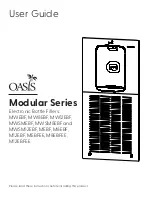
16
© Copyright 2015 Zoeller
®
Co. All rights reserved.
TROUBLESHOOTING
Symptom
Possible Cause(s)
Corrective Action
Pump won’t start or run.
1. Blown fuse.
2. Low line voltage.
3. Loose, broken or incorrect wiring.
4. Defective motor.
5. Defective pressure switch.
6. Impeller or seal.
7. Bad capacitor.
1. If blown, replace with fuse of proper size. Use time delay fuses.
2. If voltage under recommended minimum, check size of wiring from main
switch on property. If OK, contact power company.
3. Rewire any incorrect circuits. Tighten connections, replace defective wires.
4. Replace.
5. Adjust switch settings. Clean contacts with emery cloth if dirty.
6. If impeller won’t turn, remove housing and locate source of binding.
7. Replace.
Pump starts and stops too often.
1. Leak in pressure tank.
2. Defective air volume control.
3. Faulty pressure switch.
4. Leak on discharge side of system.
5. Leak on suction side of system.
6. Leak in foot valve.
1. Repair leaks or replace tank.
2. Clean or replace defective control.
3. Adjust switch settings. Clean contacts with emery cloth if dirty.
4. Repair leaks as necessary.
5. Make sure above ground connections are tight. Then repeat test. If
necessary, pull piping and repair leak.
6. Repair or replace.
Pump won’t shut off.
1. Wrong pressure switch setting or setting “drift”.
2. Defective pressure switch.
3. Loss of prime.
4. Low well level.
5. Fouled ejector.
1. Adjust switch to proper setting.
2. Replace switch if defective.
3. Reprime if necessary.
4. If undersized, replace pump or ejector.
5. Clean.
Pump operates, but delivers little or no
water.
1. Low line voltage.
2. System incompletely primed.
3. Air lock in suction line.
4. Undersized piping.
5. Leak in air volume control or tubing.
6. Leak on suction side of system.
7. Low well capacity.
8. Plugged ejector.
9. Defective or plugged foot valve and/or strainer.
10. Worn or defective pump parts or plugged impeller.
1. If voltage under recommended minimum, check size of wiring from main
switch on property. If OK, contact power company.
2. Reprime if necessary.
3. Rearrange piping to eliminate air lock.
4. Replace undersized piping or install pump with higher capacity.
5. Tighten all fittings and replace control if necessary.
6. Make sure above ground connections are tight. Repeat test. If
necessary, pull piping and repair leak.
7. Close down the valve on discharge side of pump to limit flow of water, in
keeping with well capacity.
8. Clean and reinstall if dirty.
9. Clean, repair or replace as needed.
10. Replace worn parts or pump. Clean parts if required.
Little or no discharge
1. Casing not initially filled with water
1. Fill pump casing
2. Suction lift too high, or too long
2. Move pump closer to water source
3. Hole or air leak in suction line
3. Repair or replace. Use pipe tape and pipe sealing compound
4. Foot valve too small
4. Match foot valve to piping or install one size larger foot valve.
5. Foot valve or suction line not submerged deep enough in water
5. Submerge lower in water
6. Motor wired incorrectly
6. Check wiring diagram
7. Casing gasket leaking
7. Replace
8. Suction or discharge line valves closed
8. Open
Pump will not deliver water or develop pressure
1. No priming water in casing
1. Fill pump casing
2. Leak in suction line
2. Repair or replace
3. Discharge line is closed and priming air has nowhere to go.
3. Open ball valve
4. Suction line (or valve) is closed
4. Open
5. Foot valve is leaking
5. Replace foot valve
6. Suction screen clogged
6. Clean or replace
Loss of suction
1. Air leak in suction line
1. Repair or replace
2. Suction lift too high
2. Lower suction lift, install foot valve and prime
3. Insufficient inlet pressure or suction head
3. Increase inlet pressure by adding more water to tank or increasing back
pressure
4. Clogged foot valve or strainer
4. Unclog
Pump vibrates and/or makes excessive
noise
1. Mounting plate or foundation not rigid enough
1. Reinforce
2. Foreign material in pump
2. Disassemble pump and clean
3. Impeller damaged
3. Replace
4. Worn motor bearings
4. Replace
MAIL TO: P.O. BOX 16347 • Louisville, KY 40256-0347
SHIP TO: 3649 Cane Run Road • Louisville, KY 40211-1961
(502) 778-2731 • 1 (800) 928-PUMP • FAX (502) 774-3624
Visit our web site:
zoellerpumps.com

































